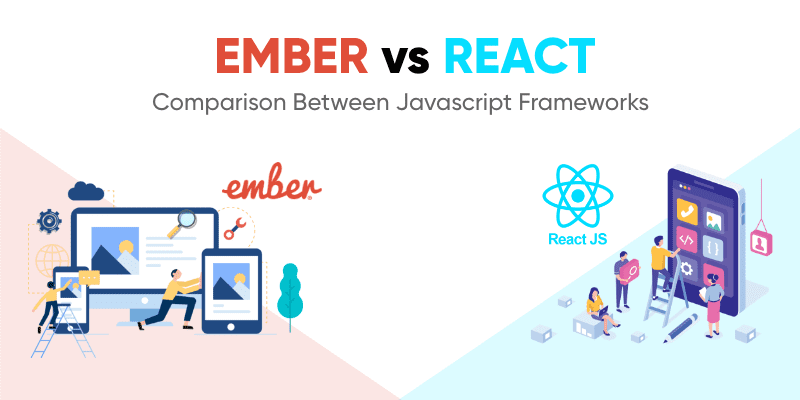Are you searching for the finest front-end framework to help you quickly develop a mobile app or website? Confused about the differences between Ember and React? Don’t worry – we might have an answer for you!
Of course, Ember and React are excellent front-end development frameworks that generate much income because of their zero-complaint user experience.
According to statistical data, most developers favor JavaScript, making it the most widely used programming language. There are numerous reasons for its widespread popularity, but we’d like to highlight the scripting language’s simplicity and relevancy.
Moreover, programming languages like JavaScript are used by many frameworks and tools in the web development world. As a result, the blog will provide an overview of the two most extensively used JavaScript tools, Ember and React. Along with comparing basic features, you’ll learn about their differences to pick the ideal option depending on your needs. So, let’s start.
What Is React.Js
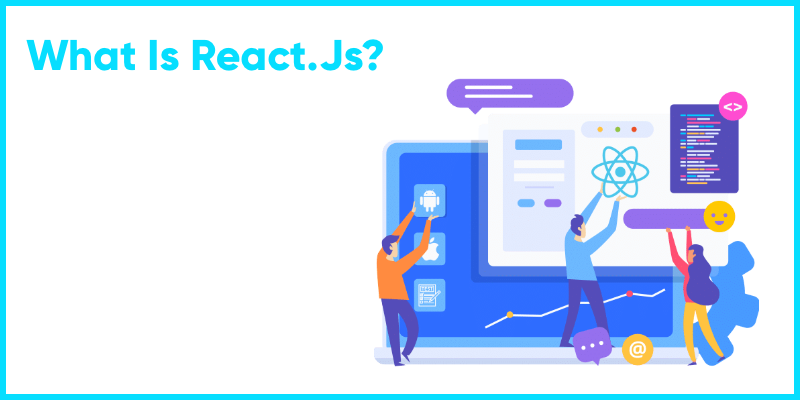
Web developers use this powerful declarative JavaScript Framework to build interactive website interfaces. It is a Facebook-developed and-maintained open-source tool. The solution also allows you to create large-scale, complicated web-based applications that deal with traffic and frequently changing data. Thus, React.js focuses on separate elements that can be reused easily. One of the most important React.js things to note is the custom syntax, JSX, which simplifies the development process.
What Is Ember.Js?
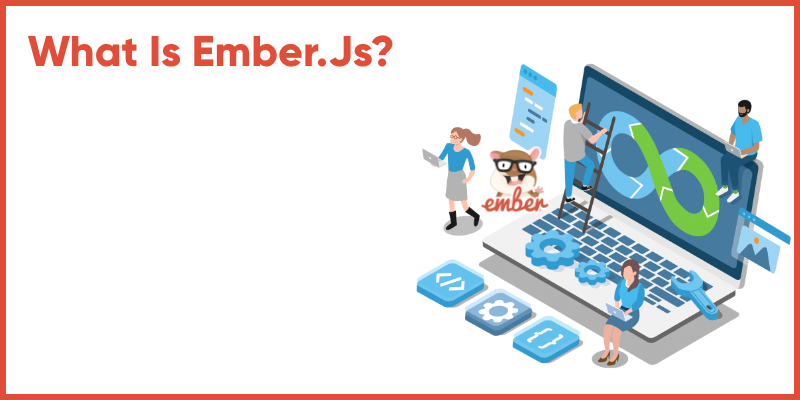
What Is React.Js Used For?
A well-structured client-side JavaScript framework for front-end developers to create powerful large-scale web applications. Ember.js, a clone of the SproutCore MVC framework, is regarded as the ideal solution for ambitious developers. The framework has several important features, such as an effective control system and tools to prevent out-of-date APIs.
Before learning about the difference between ember and react, let’s understand what its uses are:
- Highly interactive user interfaces
- Single-page applications
- Server-side rendered pages
- Reusable components
- For mobile and web applications, there is a view/presentation layer
- Accuracy of search engines
- Lightweight experiences in real-time
- Apps with frequent data updates
What Are Ember.Js Used For?
- Web apps with a lot of native features are called ambitious web apps
- Single-page apps
- Complex functionality integration
- Long-term projects
- Apps that require a Python-like programming environment
Market Share Of Ember Vs React
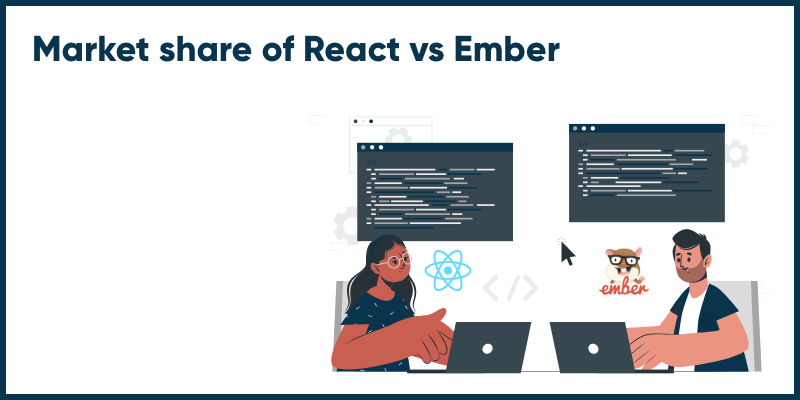
React JS
For comparison with Ember vs React, as per the 2018 State of Developer Ecosystem survey, 60% of developers use React regularly. React also appears in StackOverflow’s ‘Most Loved Frameworks of 2019’, with a score of nearly 74 percent, and StackOverflow’s ‘Topmost Requested Frameworks,’ with a score of 21.5 percent.
React is significantly more popular and liked by developers than Vue and Ember due to its elegant performance style, well-established community and platform, and vibrant ecosystem.
However, it may fall behind in creating a more organized and efficient app development process than Angular.
Ember JS
Ember.js is used by less than 0.1 percent of all websites that employ the JavaScript library, according to w3techs.
According to a Stack Overflow comparison of Ember vs React, developers are more interested in React JS and have concerns regarding its library framework. On the other hand, Ember js is far from being widely acknowledged in the app development community. Despite a surge in popularity between 2012 and 2015, the framework is barely mentioned in this developer survey.
Pros And Cons: Ember Vs React
Pros of React JS
- The component-based design allows for a simple and elegant coding pattern
- The learning curve is simple
- High productivity and performance
- Flexible: Works with third-party libraries and other MVC frameworks
- Extension of two-way data binding: simplifies DOM manipulation
Cons of React JS
- Work on essential programs and additional code
- Documentation in versions before 16 has been updated in parts.
- Browsers with limited support
Pros of Ember JS
- Documentation that is precise, bright, and updated
- A skilled, enthusiastic, and mature community
- Enterprise/Business Framework: a massive ecosystem designed for ambitious apps
- Promises and the Template Engine: more functional code and asynchronicity, better performance
- Quick, comprehensive, and adaptable
- Boilerplate code is less prone to errors: Automatic view filtering, for example, aids in the removal of redundant code.
Cons of React js
- There is no compatibility with other MVC frameworks
- Little or no customization: opts for a standard technique over a configuration approach
- Conventional practitioners adopt the “everything in place” technique, which has a steep learning curve
- (Relatively) growing community React, it’s a lot less.
Major Differences Between Ember And React
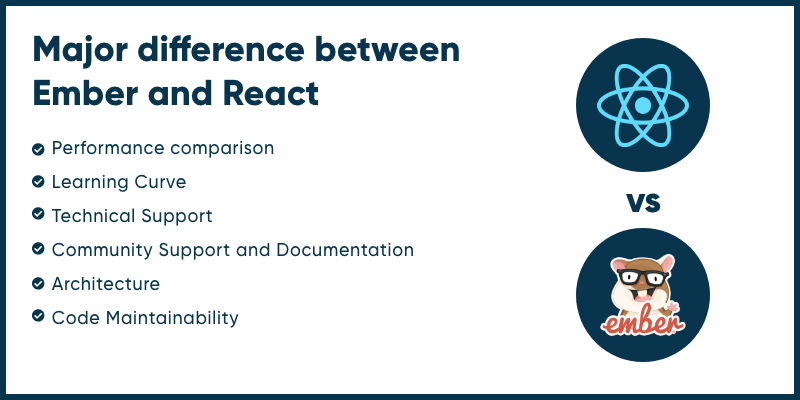
Performance Comparison
React.js development stands out when it comes to performance. It’s worth noting that the library uses the Virtual DOM rather than the Real DOM, like other frameworks. Updates are relatively fast thanks to this method, and all React components are independent. As a result, quick updates enable the creation of a highly dynamic user interface. Furthermore, connecting the DOM to it is unnecessary because React elements are already tied to the front-end’s functionality. Not only can React developers work with user interface elements faster with this method, but they can also employ Hot Reload features.
The Ember.js framework has several advantages, including high performance and server-side rendering. Because the tool combines all DOM updates and bindings, it improves efficiency. Similar tasks are grouped so a browser can handle them simultaneously rather than recalculating each separately. Furthermore, all its components are consistent because the framework is based on the Ember Object Model.
Learning Curve
Ember JS is a framework that adheres to the convention over the configuration approach. It will take a long time to learn Ember, but there is always the internet to help.
React JS is a JavaScript library with several APIs and a data flow idea. As a result, learning React JS is simple, as it is a JavaScript program that can be learned in a single day.
Technical Support
Ember-data is a data library that makes caching and querying data simple. It eliminates the client-side overhead of fetching, storing, retrieving, and caching data. Furthermore, it requires the user to adhere to best practices and encourages newcomers to adopt Ember to become comfortable with various architectures.
On the other hand, users like React JS for its virtual DOM and performance. As a result of Facebook’s scrutiny of this library, responding has developed reacting fiber, which makes it simple to use. It also assists in the introduction of new technology.
Community Support and Documentation
Ember.js has well-structured and easy-to-follow documentation, which is one of its advantages. Many helpful manuals and topic-related forums are available to assist in learning and using this framework, even though the community is substantially smaller than React’s.
React.js still lacks appropriate documentation despite being under Facebook’s watchful eye. However, because the JavaScript library’s user community is so large, finding the necessary information on the Internet is simple. The React team has also stated that they would continue to work on enhancing documentation, so there is a good probability that the future release will resolve the issue.
LinkedIn, Twitch, and Groupon are just a few companies that employ Ember.js. Facebook, Instagram, Netflix, and Uber Technologies are among the companies that use React.js.
Architecture
Ember is the best in the field of distributor logic. It has the best combination of Ember data and CLI, making working with Ember simple. Almost every programmer appreciates Ember’s basic architecture.
React JS does not come with its architecture. Those who use React prefer Flux. Flux is said to be better than MVC. Because React is fully non-opinionated and adaptable, setting up architecture for it can be difficult for newbies.
Code Maintainability
React’s component-based architecture keeps the application code structure intact. You’ll be able to concentrate more on user interface elements, implement custom hooks, and reuse stateful code. It also cuts down on coding complexity and time.
Furthermore, you can isolate application components to facilitate application migration. It enables us to develop more testable components, write future-proof component code, divide the program into smaller chunks, and access all of this rapidly.
Ember encourages excellent code practices by default, preferring conventions over configuration.
Additionally, Ember CLI and several built-in tools aid in maintaining the same project layout and common configurations. Ember’s rich configuration maintains the code and reduces the possibility of code conflicts.
It ensures that the code and various projects are organized using its standard layout and aids in flawless debugging. However, the key benefit of adopting Ember js is that any developer may see anyone’s code and comprehend the idea without the assistance of other project developers.
Conclusion
If you want to quickly and easily design and prototype web apps, you’ll need one of the JavaScript programming languages or frameworks. Choosing one, however, is a difficult task. This is owing to the significant number of frameworks accessible in the business. After reading our comparison between Ember and React, you’ve noticed a few similarities between Ember and React. Each option has its own set of advantages and disadvantages. One thing is certain: you cannot find an entirely perfect framework.
The point is that you must select the option that best meets the project’s requirements. Not only should you pay close attention to the features of a framework, but you should also consider its advantages and disadvantages to make them work in your favor.
You and your project will only flourish with such an approach. Ember.js, for example, might be the way to go if you need to construct a single-page web application quickly. Suppose you need a library to create large apps that cope with constantly changing data and significant traffic. In that case, we recommend hiring developers who are familiar with React.js and can combine it with additional tools.
So, in the Ember JS vs React JS conflict, there is no clear winner, and you can choose Echoinnovate IT the solution that best meets your requirements after weighing all the pros and cons, reading reviews, and polling the community.
FAQs
What is Ember.js?
A well-structured client-side JavaScript programming language or framework for front-end developers to create powerful large-scale web applications. Thus, Ember.js, a clone of the SproutCore MVC framework, is regarded as the ideal solution for ambitious developers. The framework has several important features, such as an effective control system and tools to prevent out-of-date APIs.
What are the pros of React js?
The component-based design allows for a simple and elegant coding pattern.
The learning curve is simple.
High productivity and performance.
Flexible: Works with third-party libraries and other MVC frameworks.
Extension of two-way data binding: simplifies DOM manipulation.
Which one should you choose: Ember js vs React js?
Both React and Ember are excellent frontend development frameworks that generate a lot of income because of their zero-complaints user experience. You can choose any of the frameworks depending on your project requirements. Still confused? Get in touch with us today!
